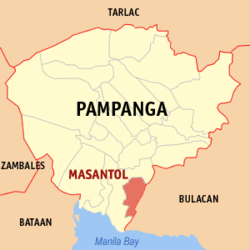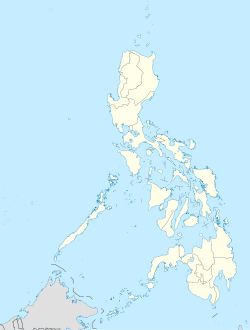- Masantol, Pampanga
-
Masantol — Municipality — Map of Pampanga showing the location of Masantol. Location in the Philippines Coordinates: 14°54′N 120°43′E / 14.9°N 120.717°ECoordinates: 14°54′N 120°43′E / 14.9°N 120.717°E Country  Philippines
PhilippinesRegion Central Luzon (Region III) Province Pampanga District 4th District Founded Barangays 26 Government - Mayor Peter B. Flores Area - Total 48.25 km2 (18.6 sq mi) Population (2007) - Total 50,984 - Density 1,056.7/km2 (2,736.7/sq mi) Time zone PST (UTC+8) ZIP code 2017 Income class 3rd class Population Census of Masantol Census Pop. Rate 1995 45,326 — 2000 48,120 1.29% 2007 50,984 0.80% Masantol is a 3rd class municipality in the province of Pampanga, Philippines. According to the latest census, it has a population of 50,984 people in 8,899 households.
Contents
History
Originally named San Miguel de Masantol and a part of the town of Macabebe, Pampanga, three of the town's leading patriarchs - Manuel Fajardo, Gregorio Bautista, and Juan Lacap - filed a motion on June 26, 1877 to separate the barrios of Bebe, Bulacus, Caingin and Nigui from Macabebe thereby creating a new Spanish pueblo called San Miguel. This new pueblo was approved by Spanish Governor General Domingo Moriones y Murillo and was inaugurated on May 1, 1878. On November 30, 1893, the Catholic Parish of San Miguel was formally acknowledged through a Royal Decree.[1]
On July 26, 1904, Masantol once more became part of Macabebe. However, in 1907, Masantol was again reinstated as a separate independent municipality and this lasted up to the present.[1]
MASANTOL HERO CLAIMING GAT. ANDRES BONIFACIO ROOTBY NOW, Kapampangans should be totally convinced that the derogatory term dugong aso is not derogatory at all. Its original meaning was "fierce and fearless" (the British general William Draper wrote that Pampangos fought like mad dogs "gnawing at our bayonets") and "loyal to a fault" (the Spaniards called Kapampangans the "loyal companions of our disgraces and our glories").
It was only later when people started interpreting dugong aso as "treacherous," which is totally the opposite of what dogs are.
I will not make excuses for their acts; I will just say that when you are colonized, you are forced to make compromises to survive. We never lived in those times and therefore never know their sufferings and the moral dilemmas they faced every single day of their tortured lives.
Besides, non-Kapampangans were just as traitorous. The Macabebe soldiers were only following orders. A Tagalog, Hilario Tal Placido, and an Ilocano, Cecilio Segismundo, defected on their own from Aguinaldo's camp and revealed his hiding place to the Americans.
All these thoughts about traitors and heroes come to mind because today, November 30, is Bonifacio Day. In life and in death, Andres Bonifacio was tormented by traitors-from fellow Katipuneros who abandoned, humiliated and executed him, to those who, after his death, disarranged, destroyed, and covered up evidence in an attempt to diminish his role in history.
At Tejeros where Katipuneros convened to choose between Aguinaldo who wasn't there and Bonifacio who was there, the electors who were mostly upper-class Caviteños chose the absentee as their new president. When they proceeded to vote for vice president, they ignored Bonifacio again and chose another Caviteño (Mariano Trias). And when they finally, reluctantly gave him the crumbs (the position of interior secretary), someone objected and had the gall to say that the Katipunan founder was not educated enough for the position. It was obvious the whole proceeding had been scripted from the start.
When the split occurred, Aguinaldo ordered Bonifacio arrested. You'd think that with Bonifacio's stature the arresting party would politely salute him before putting on the handcuffs. Instead, they barged into his headquarters and mauled him and his two brothers Ciriaco and Procopio (some say they also raped his wife Gregoria de Jesus). The mauling was so extreme that Ciriaco died on the spot. Andres was stabbed in the neck before being hauled off.
Bonifacio had to be carried on a hammock to his trial, where he and Procopio were sentenced to die by execution. Aguinaldo tasked Bonifacio's former aide, Lazaro Macapagal, to carry out the execution, perhaps to further embitter Bonifacio.
They took the Bonifacio brothers to the mountain where they were killed-Procopio shot in the back and Andres hacked with a bolo. Were they left there to rot? Were they buried in unmarked shallow graves? Was it on Mount Buntis, Mount Tala or Mount Nagpatong? No one knows for sure. They destroyed all records about Bonifacio in an effort to promote someone else's role in history, according to HAU researcher Ian Alfonso.
In life, Bonifacio was shut out because he was poor, unschooled and an outsider in the circle of Caviteño elites who controlled a bloc in the Katipunan. In death, Bonifacio was sidelined because the American colonizers considered the elite, educated and pacifist Rizal as a worthier role-model for Filipinos, and also because Bonifacio's nemesis, Aguinaldo, lived long enough to perpetuate only his version of events (he died in 1964 at age 95).
Some historians are saying that Bonifacio, not Aguinaldo, should be considered first President of the Philippines for heading the first revolutionary government before Aguinaldo's Tejeros convention replaced it. Others are suggesting that Bonifacio should be equally ranked with Rizal for launching Asia's first anti-colonial revolution that Rizal merely inspired and Aguinaldo merely continued.
Today, a group of scholars, cultural workers and common folk are coming together in Barangay Sta. Cruz, Masantol, Pampanga to mark Bonifacio Day in a special way. They will use research and folk tradition to establish Andres Bonifacio's Kapampangan roots. The project is spearheaded by HAU faculty member and researcher Joel S. Regala.
According to Regala, the Bonifacios originated in Masantol, not Tondo. His proofs? (1) A certain Domingo Bonifacio served as Macabebe capitan (mayor) in 1731. (2) More than a thousand voters surnamed Bonifacio are listed in Masantol and 256 more in Macabebe, compared to only 102 in all of Tondo. (3) There is an oral tradition among old folks in Masantol about Andres Bonifacio being their blood relative.
Regala says he cannot find hard evidence about Andres Bonifacio's birth in 1863 in Masantol because all church records were destroyed in 1898 when Aguinaldo ordered the burning of Macabebe church after the Macabebes helped the Spaniards escape from his revolutionary army. Masantol was a barrio of Macabebe until 1878.
Regala adds that Tondo is only an hour away from Masantol by boat. Then as now, Kapampangan merchants regularly went to Tondo to ply their trade. There were so many Kapampangan settlers there that they assigned a Pampanga Street.
And then, of course, there's the fact that Tondo formerly belonged to the linguistic orbit of the ancient Kapampangan Region.
When Andres Bonifacio founded the Katipunan, he had Kapampangans with him, most notably Aurelio Tolentino. After Bonifacio's death, Aguinaldo also got help from Kapampangan generals (Maximino Hizon, Jose Alejandrino, Francisco Makabulos, Servillano Aquino).
Other heroes had Kapampangan blood in them, too. Marcelo H. del Pilar was a cousin of the Hilarios of Bacolor (the H in his name stands for Hilario). Jose Rizal was related to the Mercados of Sasmuan (his father Francisco Mercado was descended from Domingo Lamco of Guagua).
With so many Kapampangan patriots and heroes, I don't understand why some people stay fixated on the few traitors.
As for the Macabebes, let me just say that even Aguinaldo himself asked to be photographed with them after his capture. Enough said
They must be referring to the Macabebes who helped the Americans capture Aguinaldo, and to two Macapagals in history: Juan Macapagal of Arayat who helped the Spaniards put down the Kapampangan Revolt of 1660, and Lazaro Macapagal who carried out the execution of Andres Bonifacio in 1897.Published in the Sun.Star Pampanga newspaper on November 29, 2010.
Barangays
Masantol is politically subdivided into 26 Barangays. and 2 independent/Dependent Barrio
- Alauli
- Bagang
- Balibago
- Bebe Anac
- Bebe Matua
- Bulacus
- San Agustin (Caingin)
- Santa Monica (Caingin)
- Cambasi
- Malauli
- Nigui
- Palimpe
- Puti
- Sagrada (Tibagin)
- San Isidro Anac
- San Isidro Matua (Pob.)
- San Nicolas (Pob.)
- San Pedro
- Santa Cruz
- Santa Lucia Matua
- Santa Lucia Paguiaba
- Santa Lucia Wakas
- Santa Lucia Anac (Pob.)
- Sapang Kawayan
- Sua
- Santo Niño
Barrio
- Bebe Arabia
- Sagrada 2 (sagrada dos)
==Education== Masantol is home to several primary and secondary schools, among them are:
- Bagang Elem. School
- San Miguel Academy Semi-Catholic School
- Holy Child of Mary Academy Semi-Catholic School
- Masantol Elementary School (Masantol Central Elementary School)
- Masantol High School
- Masantol High School Annex in Sagrada (Tarik Suliman High School)
- St. Michael The Archangel Archdiocesan Parochial School Exclusive Catholic School(Masantol Parochial School)
- Pampanga Institute''' - 1st high school institution in town of Masantol
- Masantol High School Annex -(Malauli High School)
- Caingin Elem. School
- Palimpe Elem. School
- Bebe Anac Elem. School
- Bebe Matua Elem School
- Puti Elem. School
- Sagrada Elem. School
- Sua Elem. School
- San Isidro Elem. School
- Balibago Elem. School
Tragedy
On January 7, 2008, one person drowned, another missing and 40 others were injured due to electric shocks, when a live cable hit the floating pagoda boat in the fluvial festival at Barangay Malauli, Masantol, Pampanga, Philippines in honor of Virgen La Purisima Concepcion.[2]
Festivities
- Viva San Miguel Arkangel - May 8, All Masantolenos
- Viva Sto. Nino - every last Sunday of January. - Brgy. Sto. Nino
- Viva Santa Monica - every 3rd Sunday of April. - Brgy. Santa Monica Caingin
- Batalla and Talangka Festival of San Roque - every 3rd Sunday of April. - Brgy. Bebe Anac, Bebe Matua, and Bario Bebe Arabia
- Batalla Festival of San Miguel - every May 8 of the year. - Masantol Town Proper
- Feast of Apung Kulas - every May 12 of the year. - Brgy. San Nicolas
- Feast of The HOLY ROSARY - every 2nd Saturday of October in BULACUS MASANTOL
- Fiesta de Santa Lucia - every December 13 of the year. - Brgy. Santa Lucia Wakas, Matua, Anac
- Viva San Agustin - every August 28 of the year. Brgy. San Agustin Caingin
- The Labas Larawan (Celebration of the Saints) in each barrio/barangay celebrating their patron saint for one week in January.
- A week long "Barrio Feista" for each barrio scattered throughout the year.
External links
- www.gmanews.tv/video, Body of Pampanga fluvial parade mishap victim recovered, 01/08/2008
- Philippine Standard Geographic Code
- 1995 Philippine Census Information
- 2000 Philippine Census Information
- 2007 Philippine Census Information
References
Municipalities Component city Highly urbanized city (Administratively independent from the province, but grouped under Pampanga by the National Statistics Office)Categories:- Municipalities of Pampanga
Wikimedia Foundation. 2010.


